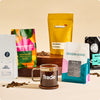What is Decaf Coffee?
Decaf is coffee that has had its caffeine — the naturally occurring compound largely responsible for giving you the energy boost you feel after drinking coffee — removed by some sort of decaffeination process.
Where Does Decaf Come From?
While the level of caffeine content in a given coffee varies by the coffee bean’s plant variety and how you brew your drink, there is no commercially grown coffee plant that is caffeine-free by nature.
It's Time for a Soak
The decaffeination method starts with green coffee beans — seeds of coffee cherries that have been separated from their fruit and dried, but not yet roasted. The legend goes that decaf coffee was discovered when coffee beans fell overboard from a ship and became less caffeinated by the salt water soak. From there, the first patented decaffeination methods used a chemical solvent like ammonia and benzene.
As you might expect, the world at large eventually turned on the idea of using benzene in something we drink, but the general soaking concept proved long-lasting. Currently popular methods replace that ammonia and benzene cocktail with chemicals like Methylene Chloride or Ethyl Acetate, which might have scary names, but are definitely safe at the amounts used to make decaf and preserve coffee’s flavor relatively well. Another popular method involves using pressurized Carbon Dioxide to strip a coffee’s caffeine.
The Swiss Water process (which is actually based in British Columbia), uses a green coffee extract to help that caffeine travel out of the green coffee while losing as little of the other materials in it as possible
Flavor Matters
Decaffeination involves the breakdown of the structure of a coffee bean in a way that will affect its flavor when it’s roasted. It might also affect its appearance, as the breakdown of cell walls in decaffeination can make it easier for oils to escape the beans even in medium roasts (while, in caffeinated coffee, oils are something we don’t usually see unless it’s dark roast coffee). Finally, while caffeine isn’t the main compound that makes coffee bitter, it does contribute to that flavor, so its removal can actually reduce bitterness.
But is Decaf Coffee Really Decaf?
While no decaffeination processes offer a 100 percent caffeine-free product, most decaf coffee has a negligible amount of caffeine. Swiss Water’s website promises 99.9 percent caffeine reduction, while studies of other methods commonly used in specialty found results close to 97 percent. It’s likely that decaffeinated coffee won’t give you any sort of caffeine buzz. However, it might still be wise to ingest decaffeinated coffee with caution for those with extreme intolerance to caffeine consumption.
FAQs
What is certified decaf coffee?
- Certified decaf coffee is coffee that has undergone a process to remove most of the caffeine while retaining the flavor and aroma of the beans. Certification ensures that the decaffeination process meets specific standards set by organizations like Fair Trade or USDA Organic.
How is decaf coffee made?
- Decaf coffee is typically made using one of several decaffeination methods, such as the Swiss Water Process or the CO2 method. These methods use water or carbon dioxide to extract caffeine from the beans while preserving their flavor.
Is decaf coffee as flavorful as regular coffee?
- While some people may notice a slight difference in flavor between decaf and regular coffee, many high-quality decaf coffees are indistinguishable from their caffeinated counterparts. The key is to choose decaf coffee made from freshly roasted beans and brewed properly.
Does decaf coffee still contain caffeine?
- Decaf coffee is not completely caffeine-free, but it contains significantly less caffeine than regular coffee. According to FDA regulations, decaf coffee must have at least 97% of its caffeine removed.
Is certified decaf coffee better for the environment?
- Certified decaf coffee often comes from sustainable sources and is produced using environmentally friendly practices. You can support ethical and eco-conscious coffee producers worldwide by choosing certified decaf coffee.
Why Trade Coffee?
At Trade, we pride ourselves on curating a diverse range of premium coffees sourced from top roasters nationwide. Whether you're a discerning connoisseur or a novice enthusiast, our personalized recommendations ensure that each cup caters to your unique taste preferences.
Getting started with Trade is simple. Take our coffee personalization quiz, where you'll share your flavor preferences and brewing habits. Based on your responses, we'll handpick coffees tailored to your palate and deliver them freshly roasted to your doorstep.
Beyond being a coffee subscription service, Trade is a vibrant community united by a shared love for exceptional brews. Our team of coffee aficionados is committed to sourcing the finest beans and empowering you with the knowledge and tools needed to craft the perfect cup at home.
Subscribe Now









